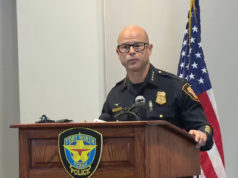It’s tough being an environmentalist in Texas – not as bad as being a snowball in hell, but perhaps akin to rolling a very large snowball up a very tall hill, while hostile types shoot arrows at you from behind every rock.
If the Powers That Be aren’t trying to sell potential parkland to developers, somebody’s wanting to stick a gas well in it, or pave it, or allow some cement maker to burn hazardous wastes right beside it. The snowball in today’s lesson is the hoped-for Fort Worth Prairie Park, a brainchild of Jarid Manos, executive director of the Great Plains Restoration Council. He’s been trying for a couple of years to save a nice swath of undeveloped land on Fort Worth’s southern border, dealing with the state land commissioner who wants to sell it for development and a city council that can’t concentrate on the environment long enough to vote support for the idea (see our cover story this week).
Now comes a trailer park operator, asking the Texas Commission on Environmental Quality for permission to dump about 10,000 gallons a day of treated sewage into Rock Creek just above where it flows into the prairie acres. Manos describes the “still-wild, pristine creek” as the lifeblood of his proposed park. There are other ways the trailer park could handle its sewage, he said, than by letting it run off into the creek after it’s treated. For one thing, Manos said, in hot weather the creek often doesn’t run strongly at all – meaning that pollutants dumped in upstream won’t be continuously flushed out but could settle into the ground. Studies of aquatic life haven’t been completed, he said, so there’s no knowing what critters might get 86’d by the addition of those not-so-pristine currents.
Manos is asking folks to write letters to TCEQ on the issue, but the catch is that they need to be in by Nov. 15, when the state environmental agency – not the strongest advocate that living things and clean water ever had – holds a hearing on the permit request. Manos said folks can bring or send letters to his group (www.gprc.org; 817-838-9022) and they’ll deliver them to the hearing, which will be at 7 p.m. Thursday at the Joshua Community Room, 909 S. Broadway St., Joshua.
Y’all come, Manos said, and help him explain to the commissioners that “you don’t have to profane everything.”
Humpty Dumpty’s No. 1!
In 2005, freelancer Wendy Lyons Sunshine wrote a cover story for Fort Worth Weekly (“Healing Humpty Dumpty,” April 6, 2005) about some groundbreaking brain chemistry discoveries and therapy techniques being employed by researchers at Texas Christian University to achieve significant breakthroughs in reaching children – many of them who’d been adopted from abroad – whose behaviors in some cases were so violent and disruptive that families were being torn apart. Her story led to a book, co-authored with the TCU researchers, Karyn Purvis and David Cross, director and co-director of Texas Christian University’s Institute of Child Development.
The how-to book, called The Connected Child, has gone into a second printing, and Purvis’ and Cross’ work continues to gain recognition around the world. But one of Sunshine’s biggest thrills came a few weeks ago – she can tell you the exact date, Oct. 8 – when the book hit No. 1 in Amazon.com’s adoption books category for the first time. It’s done it again on several occasions and has also been rated occasionally in the top 20 most popular books in the online bookseller’s broader “parenting and families category.”
Sunshine, whose articles for the Weekly have won regional and national journalism awards, is working on another book on a different topic. But she admits to keeping close tabs on the Amazon rankings. Being No. 1 in a fairly narrow category may not make her or Purvis or Cross the next J. K. Rowling – but it sure gives them some warm fuzzies.











Why visitors still use to read news papers when
in this technological world all is available on net?